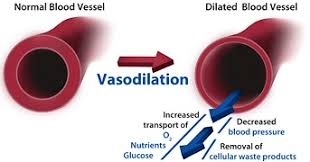Vasodilators are medications that open (dilate) blood vessels. They prevent the muscles in the walls of arteries and veins from tightening and narrowing. As a result, blood flows more easily through the vessels.1 These medications often have side-effects.
Your body naturally produces its own vasodilators in the form of nitric oxide gas molecules. Endothelial cells line the interior surface of blood vessels and lymphatic vessels. It is there that nitric oxide is synthesized from the interaction of an amino acid and an enzyme and then released throughout the body. Nitric oxide gas diffuses through the cell walls to transmit signals to the cardiovascular, nervous, and immune systems. Nitric oxide signals the body to2:
· Reduce blood pressure.
· Expand and relax blood vessels so that more blood, nutrients, oxygen flow to all parts of your body.
· Enhance blood flow necessary for male sexual performance.
· Kill infectious bacteria.
· Make energy supplying mitochondria more effective.
· Make muscles more efficient; requiring less oxygen to work out at higher intensities i.e. it's easier for you to push yourself harder.
Nitric oxide levels decline as we age, but we can forestall that. Eat beets and spinach, and get plenty of sunlight and exercise. What type of exercise is best?
According to these studies (study 1 and study 2) “It has been shown high intensity interval training (at 85% to 90% of VO2 max) is more effective in improving endothelial function and nitric oxide availability than continuous moderate aerobic exercise. These studies were done in humans and rats with metabolic syndrome and found that high intensity interval training reversed more risk factors of metabolic syndrome than did continuous moderate aerobic exercise”3.
There is a positive cycle. Exercise increases nitric oxide availability resulting in blood flow increases. This leads to an increase in the capacity for more exercise further facilitating even more nitric oxide availability.
When you push your body to do more than it is used to handling, as self-protection, your body makes a long list of positive cardiovascular adaptations; improved nitric oxide availability is just one of those adaptations.
Our goal at Austin Personal Training is to safely “dose” clients with the right amount of high intensity training to effectively make those positive changes. People of any age or fitness level can do this and it does not require hours in the gym each week. Do a little bit more each week; you’ll improve a little each week, and over time your health and well-being will improve dramatically. Do nothing, a negative cycle begins, and you know how that ends.
Request a complimentary first session at Kelly Personal Training
Click here to schedule a session to try it yourself
*Before you stop by please call us. We operate by appointment.
2 https://www.shape.com/fitness/tips/how-boost-your-nitric-oxide-levels-without-supplements
3 https://livelongstayyoung.com/boosting-nitric-oxide-with-exercise/


